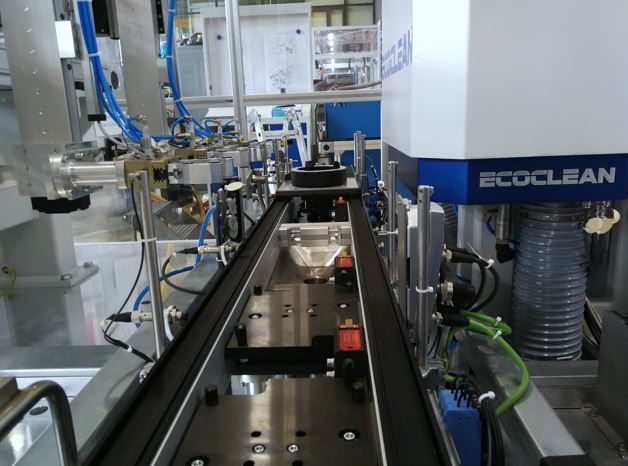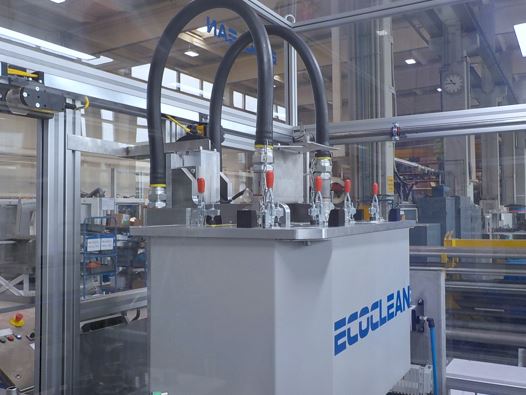Automotive & E-Mobility
Dry cleaning electric motors in the automotive industry
Highly automated solution ensures excellent cleanliness results and short cycle times
When it comes to assembling complex electrical units, it is impossible to avoid contamination. At a renowned automotive supplier, a customized dry-cleaning solution from Ecoclean prevents particles from causing malfunctions during the later use in power steering systems. The highly automated process also enables extremely short cycle times.
With the growing use of energy-efficient drive systems - be they hybrid, purely electric or optimized combustion engines - an increasing number of vehicles are being fitted with driver assistance systems, such as parking assistance, lane departure warning, motorway pilot and automatic evasion, right up to autonomous driving. The components that control and execute these functions must guarantee maximum safety and reliability. Such parts include the electric motors for power steering, which are constantly being further developed by system manufacturers and adapted to new requirements.
Assembly processes as a source of recontamination
Stricter specifications apply not only to the technical cleanliness of the components, but also to assembly lines. This is because particles are often generated by assembly processes. The focus is not just on metallic particles, which can impair the performance of electric motors and cause shorting in later operation. There is also a risk from non-metallic contamination and fibres because these can become electrically conductive if they absorb moisture.
At a renowned automotive supplier, the final inspection showed that an existing air-operated dry cleaning system integrated into the assembly line did not meet the cleanliness specifications. The Tier-1 supplier’s project managers therefore turned to Ecoclean GmbH for help. At its Monschau site, the company has a wealth of experience in dry cleaning with compressed air and vacuum technology, which have been further developed for various tasks in the field of electric mobility.
Process and machine design through simulation and testing
Since this cleaning task is not an “off-the-peg” application, a special test set-up was used to design the process. The necessary tools were developed with the aid of flow simulation. This not only ensures that the cleaning process uses the media as efficiently as possible, but also that the detached particles are reliably removed from the treatment chamber. The fact also had to be taken into account that smaller particles are less likely to spontaneously detach from the surface on contact with the cleaning medium. The simulations made it possible to adapt the nozzle openings to the respective geometries of the seven different motors and variants. This ensures optimum media application and thus maximum cleaning efficiency with the lowest possible operating costs. The nozzle systems were manufactured by 3D printing.
For the cleaning tests, standard particles with emulsion were applied to the complex electrical units and then dried in an oven for approximately one hour to be certain that the contamination adhered strongly to the surface. Already during the first trials the cleaning process achieved results that were significantly better than those demanded by the cleanliness specifications.
Reliable, automated cleaning process with short cycle times
A further requirement when integrating the developed process into a system concept was that the cleaning process had to be completed within 7.8 seconds per part. To meet this demand, Ecoclean designed a highly automated system equipped with two processing stations and two manipulators, each with double grippers. The nozzle systems adapted to the respective electric motors are located in a tool rack. An RFID chip, which is fitted to each electric motor and scanned when the motor is fed into the cleaning system, provides the manipulators with the necessary information about which tools to use. The tools are changed by means of a quick-change system.
The first manipulator takes two motors at a time from the part carriers which are used to transport the parts to the machine and positions them in the first station. Here deep threaded holes are blown clean by permanently-monitored needle nozzles. After the specified cleaning time, manipulator 1 places the parts in process station 2, moves back and picks up two new parts.
In station 2, which is designed as a blow box, the electric motors are blown clean in line with their geometry by the adapted nozzle system. During the process, the blow blade rotates to prevent any areas with a poor airflow (dead zones) from forming. The process uses the lowest possible mains pressure. After the allotted cleaning time, the parts are removed by manipulator 2, which places them back on cleaned part carriers.
Preventing recontamination
In order to obtain a consistently good cleaning result, not only must contamination be reliably removed from components but a method must also be found to prevent it from spreading to the surroundings. A closed blow box was used to achieve this. Thanks to the special design of the walls, detached particles are continuously removed by the extraction system. The air used for this step is filtered before being discharged into the production area.
As particles posing a recontamination risk may also be present on the part carriers, these are cleaned in a separate blow-cleaning process while the components are being treated in stations 1 and 2. The same particle size specifications as those for the electric motors must be met.
Connection to the MES with process data transfer
The machine is equipped with a newly-developed, Industry 4.0-compatible controller that is integrated into the Tier 1 supplier’s Manufacturing Execution System (MES). To ensure the traceability of the cleaning process as demanded by the customer, process parameters such as the process pressure in the two stations are continuously monitored and the data transmitted to the MES.
By optimally adapting the cleaning processes to the specific parts, the excellent cleaning results achieved in the trials are also consistently attained in series production. The company now operates three of these machines at two different production sites.
Author: Doris Schulz



